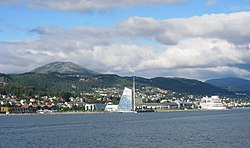Molde | |
|---|---|
 View of the town | |
| Nickname: Town of Roses | |
| Coordinates: 62°44′15″N 7°09′33″E / 62.7375°N 7.1591°E | |
| Country | Norway |
| Region | Western Norway |
| County | Møre og Romsdal |
| District | Romsdal |
| Municipality | Molde Municipality |
| Established as | |
| Ladested | 1614 |
| Kjøpstad | 1742 |
| Area | |
| • Total | 9.08 km2 (3.51 sq mi) |
| Elevation | 4 m (13 ft) |
| Population (2019)[1] | |
| • Total | 21,103 |
| • Density | 2,324/km2 (6,020/sq mi) |
| Demonyms | Moldenser Moldensar |
| Time zone | UTC+01:00 (CET) |
| • Summer (DST) | UTC+02:00 (CEST) |
| Post Code | 6400 Molde |
Molde (Norwegian pronunciation: [ˈmɔ̂ɫdə] ) is a city in Molde Municipality in Møre og Romsdal county, Norway. The city is located along the Moldefjorden and the river Molde. The city is the largest urban and commercial centre of the Romsdal region as well as the administrative centre of Molde Municipality and of Møre og Romsdal county. The Church of Norway's Diocese of Møre is also based at the Molde Cathedral.[3]
Molde has a maritime, temperate climate, with cool-to-warm summers, and relatively mild winters. It is nicknamed The Town of Roses.[4]
The settlement emerged as a shipping port for lumber to the Netherlands in the late 1500s.[5]: 24 Formal trading rights were granted at some point before 1604,[6]: 79–87 and the town was incorporated through a royal charter in 1742. Bolsøy Municipality, which later merged with Molde town, was established on 1 January 1838 (see formannskapsdistrikt law).[3]
The town continued to grow throughout the 17th to 19th centuries, becoming a centre for the Norwegian textile and garment industry, as well as the administrative centre for the region, and was a major tourist destination until World War I. After World War II, Molde experienced accelerated growth, merging with Bolsøy Municipality and parts of Veøy Municipality and Nord-Aukra Municipality on 1 January 1964, making the municipality much larger than the urban area of the town of Molde. On 1 January 2020, the municipality was expanded again through the incorporation of the neighboring municipalities of Midsund and Nesset.
The 9.08-square-kilometre (2,240-acre) town has a population (2019) of 21,103 and a population density of 2,324 inhabitants per square kilometre (6,020/sq mi).[1]
- ^ a b c Statistisk sentralbyrå (1 January 2019). "Urban settlements. Population and area, by municipality".
- ^ "Molde, Molde (Møre og Romsdal)". yr.no. Retrieved 2019-06-30.
- ^ a b Thorsnæs, Geir, ed. (2018-09-26). "Molde". Store norske leksikon (in Norwegian). Kunnskapsforlaget. Retrieved 2019-06-30.
- ^ "Molde - Jazz, roses and panoramic views". Visit Norway. Retrieved 18 August 2018.
- ^ Kvernberg, Anders (2021). Molde byleksikon. Romsdal sogelag. ISBN 9788293345176.
- ^ Kvernberg, Anders (2022). "'Ladeplatzen udi Molde Fiære' – et kritisk blikk på noen av Bolsøybokas mytedannelser". Årsskrift (in Norwegian). 86. Romsdal sogelag: 79–87.

